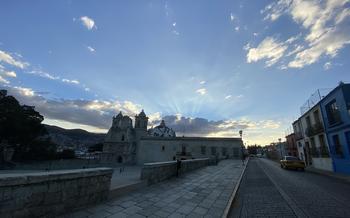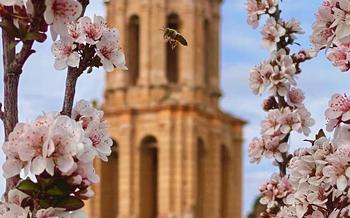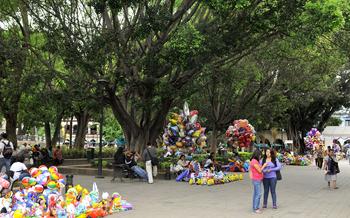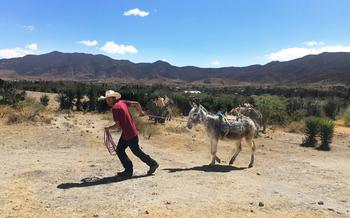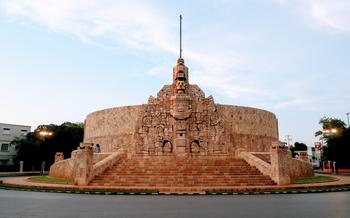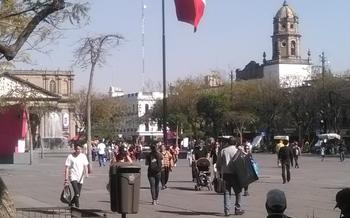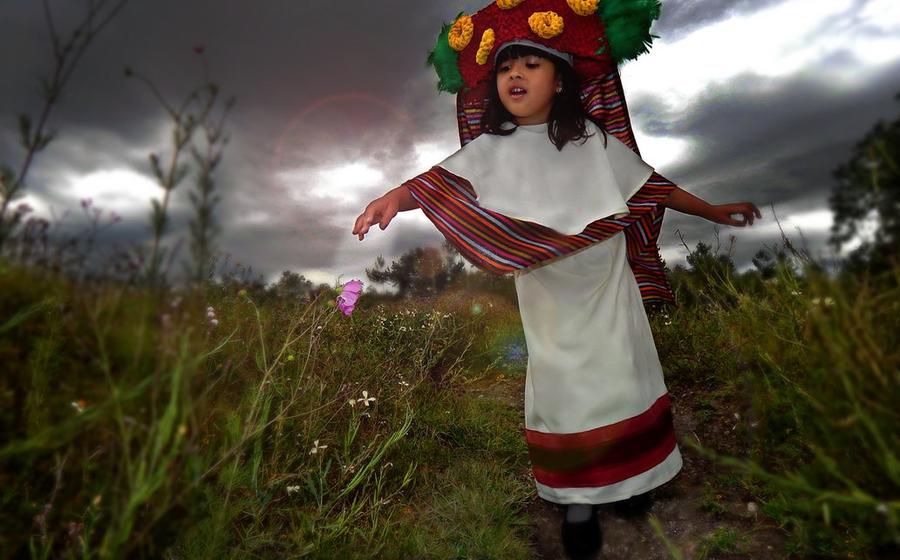
Pachuca’s Monumental Clock
- The Pachuca’s Monumental Clock: A Symbol of Time and Industry
- Location and Accessibility
- History and Construction
- Architectural Design and Features
- The Clock Mechanism
- Symbol of Pachuca's Mining Heritage
- Cultural and Historical Significance
- Views from the Clock Tower
- Exploring the Surroundings
- Events and Festivals
- Admission and Hours of Operation
- Accessibility for Visitors with Disabilities
- Photography and Videography
- Local Cuisine and Restaurants
- Insider Tip: Hidden Gems and Secret Spots
The Pachuca’s Monumental Clock: A Symbol of Time and Industry
The Pachuca’s Monumental Clock, also known as the Reloj Monumental de Pachuca, stands as a symbol of time, industry, and the rich heritage of the city. Erected in 1910, this iconic clock tower has become synonymous with Pachuca, serving as a beacon of progress and a reminder of the city's mining roots.
The clock's construction was a testament to the city's prosperity during the mining boom of the late 19th and early 20th centuries. Pachuca, renowned for its silver mines, was a bustling hub of activity, and the clock tower was commissioned to commemorate the city's achievements and pay homage to the miners whose labor fueled its growth.
Designed by the British engineer William H. Adams, the clock tower exhibits a blend of architectural styles, showcasing elements of French and English influence. Its intricate details, including the four faces of the clock, the bell tower, and the elaborate carvings, reflect the craftsmanship and artistry of the era.
As a symbol of Pachuca's mining heritage, the clock tower holds cultural and historical significance for the city's residents. It represents the spirit of innovation and perseverance that has shaped Pachuca's identity, making it a beloved landmark and a must-visit destination for anyone exploring the city's rich past and vibrant present.
Location and Accessibility
The Pachuca's Monumental Clock stands tall in the heart of the city, at the intersection of Avenida Revolucion and Calle Miguel del Futbol.
To reach the clock tower, visitors can take public transportation, such as the Tuzobús rapid transit system, which has a stop just a few blocks away. Alternatively, taxis are readily available and provide a convenient way to get around the city.
For those arriving by car, there are several parking options nearby, including metered street parking and private parking lots. However, it is important to note that the area can be quite busy, so finding a parking spot may require some patience, especially during peak tourist seasons.
To avoid crowds and enjoy a more tranquil experience, it is recommended to visit the clock tower early in the morning or on weekdays, when there are fewer tourists.
History and Construction
The Pachuca's Monumental Clock, a testament to human ingenuity and precision, was brought to life through the collaboration of British engineer William H. Adams and local craftsmen. Adams, renowned for his expertise in horology, meticulously designed the clock's intricate mechanism, ensuring its accuracy and reliability. The clock's construction, a feat of engineering, took place in England, where skilled artisans crafted each component with utmost care and precision. The clock's journey to Pachuca was a logistical marvel, requiring careful planning and coordination to transport the delicate mechanisms across the ocean. Upon its arrival in Mexico, the clock was assembled and installed atop the clock tower, a testament to the dedication and perseverance of those involved in its creation. The clock's inauguration in 1910, coinciding with the centennial of Mexico's independence, was a momentous occasion, marking a new chapter in Pachuca's history and solidifying the clock's status as a symbol of the city's progress and prosperity.
Architectural Design and Features
The Pachuca's Monumental Clock stands as a testament to the ingenuity and craftsmanship of its creators. The tower's structure is a harmonious blend of neoclassical and art nouveau styles, showcasing intricate details and elegant ornamentation. Its foundation is laid with solid stone blocks, providing a sturdy base for the towering structure that rises above.
The clock tower's facade is adorned with decorative elements such as pilasters, friezes, and cornices, adding depth and visual interest to its exterior. The use of wrought iron railings and balconies lends a touch of lightness and airiness, creating a graceful contrast to the solidity of the stonework.
The clock faces, positioned on each side of the tower, are a marvel of engineering and artistry. Crafted from intricately designed metal frames, they display large, easy-to-read numerals that can be seen from afar. The hands, meticulously crafted from cast iron, move with a steady rhythm, marking the passage of time with precision.
Atop the tower, a majestic bell sits proudly, encased within an ornate metal structure. The bell, cast from a special alloy, produces a deep, resonant sound that echoes through the city, marking the hours and special occasions with its sonorous toll.
The symbolism embedded in the clock's design adds another layer of depth to its allure. The four faces of the clock represent the four cardinal directions, symbolizing the clock's role as a guide and a symbol of unity. Motifs of mining and industry, such as gears, cogs, and hammers, are incorporated into the design, paying homage to Pachuca's mining heritage.
The Clock Mechanism
The Pachuca's Monumental Clock stands as a testament to the precision and craftsmanship of its intricate mechanism. Each component, meticulously crafted and assembled, works in harmony to ensure the clock's accuracy and longevity. The gears, wheels, and levers engage in a delicate dance, driven by the steady beat of the pendulum. The heart of the clock, the escapement, releases the energy stored in the weights, allowing the hands to move forward with a smooth, unwavering rhythm.
The clock's mechanism is a marvel of engineering, a testament to the skill and dedication of its creators. Regular maintenance and upkeep are essential to keep the clock functioning flawlessly. Skilled technicians carefully inspect and adjust the mechanism, ensuring that every component operates in perfect harmony.
A fascinating anecdote is associated with the clock's operation. During a particularly strong earthquake, the clock continued to keep time accurately, despite the violent shaking that caused damage to surrounding buildings. This remarkable resilience showcased the clock's exceptional craftsmanship and the dedication of those who maintain it.
The Pachuca's Monumental Clock stands as a symbol of precision, craftsmanship, and resilience, a testament to the enduring spirit of its creators and the city it represents.
Symbol of Pachuca's Mining Heritage
The Pachuca’s Monumental Clock stands as a testament to the city's rich mining history. Pachuca has long been renowned for its silver mining, and the clock serves as a symbol of the industry that shaped the city's development and prosperity. The clock's intricate design incorporates motifs and symbols related to mining, such as gears, cogwheels, and pickaxes, paying homage to the miners who toiled underground to extract the precious metals that fueled Pachuca's growth.
One of the most striking anecdotes related to the clock's connection to mining involves a group of miners who, upon hearing the clock's bell toll for the first time, believed it was a signal to return to work. This humorous misunderstanding highlights the deep connection between the clock and the city's mining heritage, as well as the miners' unwavering dedication to their craft.
To this day, the clock continues to hold a special place in the hearts of Pachuca's residents, serving as a reminder of the city's mining roots and the generations of miners who have contributed to its success.
Cultural and Historical Significance
The Pachuca’s Monumental Clock holds immense cultural and historical significance, deeply entwined with the identity and heritage of the city. Recognized as a cultural heritage site, the clock tower stands as a testament to Pachuca's rich past and serves as a symbol of its unique character. Over the years, the clock has witnessed countless historical events and milestones, becoming an integral part of the city's narrative. Locals and visitors alike cherish the clock as a beloved landmark, a source of pride, and a reminder of Pachuca's enduring spirit.
Traditions and celebrations surrounding the clock further enhance its cultural significance. The annual clock festival, held each September, attracts throngs of visitors who come to witness the clock's intricate workings and celebrate Pachuca's mining heritage. During the festival, the city comes alive with music, dance, and traditional performances, creating a vibrant atmosphere that captivates all who attend. These events not only showcase the clock's cultural importance but also provide a glimpse into the rich tapestry of Pachuca's traditions.
Views from the Clock Tower
The Pachuca's Monumental Clock offers breathtaking panoramic vistas of the city and its surroundings from its observation deck. Visitors can ascend to the top of the clock tower to enjoy unparalleled views that stretch far and wide. The observation deck provides a unique perspective, allowing visitors to admire Pachuca's architectural landmarks, such as the Catedral de Pachuca and the Palacio de Gobierno, from a bird's-eye view. On a clear day, visitors can even catch glimpses of the distant mountains and the sprawling valleys that surround the city. The observation deck is a must-visit for anyone seeking to capture stunning photographs and create lasting memories of their time in Pachuca.
Exploring the Surroundings
The Pachuca's Monumental Clock stands as a prominent landmark in the heart of the city, surrounded by a treasure trove of attractions that invite exploration. Within easy walking distance, visitors can delve into the rich history and vibrant culture of Pachuca.
Just a few steps away, the Museo de Minería offers a fascinating glimpse into the city's mining heritage. Interactive exhibits and historical artifacts tell the story of the region's mining industry, which played a pivotal role in Pachuca's development.
Art enthusiasts will find delight in the Museo de Arte de Pachuca, showcasing a diverse collection of Mexican and international art. From traditional paintings to contemporary sculptures, the museum offers a feast for the eyes and a journey through different artistic expressions.
Nature lovers can seek refuge in the tranquil Parque David Ben Gurión, a verdant oasis in the midst of the urban landscape. With its lush gardens, serene ponds, and winding paths, the park provides a peaceful escape from the city's hustle and bustle.
For those seeking a taste of local flavors, the Mercado Benito Juárez is a must-visit. This vibrant market bustles with activity as vendors offer an array of fresh produce, traditional Mexican dishes, and handcrafted souvenirs. Visitors can indulge in culinary delights and immerse themselves in the authentic atmosphere of a traditional Mexican marketplace.
These are just a few of the many attractions that await visitors in the vicinity of the Pachuca's Monumental Clock. By venturing beyond the clock tower, travelers can uncover the hidden gems of Pachuca and create a truly memorable and enriching experience.
Events and Festivals
The area surrounding the Pachuca's Monumental Clock comes alive during special events and festivals, transforming it into a vibrant hub of cultural expression. One of the most notable annual events is the Pachuca International Cultural Festival, held in September. This month-long extravaganza showcases a diverse array of music, dance, theater, and art performances from around the world. Visitors can witness traditional Mexican dances, listen to live music concerts, and admire stunning art exhibitions, all while immersing themselves in the infectious energy of the festival.
Other popular events include the Pachuca Day Festival in October, which celebrates the city's rich history and heritage with parades, live music, and traditional food fairs. The Day of the Dead festivities in November are also a sight to behold, with colorful altars, parades of whimsical costumes, and vibrant celebrations honoring the memory of loved ones. Attending these events offers a unique opportunity to experience Pachuca's vibrant cultural tapestry and connect with the locals on a deeper level.
Admission and Hours of Operation
Visiting the Pachuca's Monumental Clock is an affordable experience, with general admission tickets priced at a reasonable rate. Discounted rates are available for students, seniors, and children. The clock tower is open to the public daily, with extended hours during peak tourist seasons. Guided tours are offered in Spanish and English, providing an in-depth exploration of the clock's history and significance. Audio guides are also available for a more self-guided experience.
For the most memorable visit, plan your trip during the daytime to fully appreciate the clock's intricate details and the panoramic views from the observation deck. If you're a photography enthusiast, consider visiting during the golden hours of sunrise or sunset to capture stunning shots of the clock tower bathed in warm light.
Accessibility for Visitors with Disabilities
The Pachuca's Monumental Clock is committed to ensuring accessibility and inclusivity for all visitors, including those with disabilities. Wheelchair users and individuals with limited mobility can easily access the clock tower and its surroundings. Designated parking spaces are available near the entrance, and accessible ramps and elevators provide convenient access to all levels of the tower. Inside, wide corridors and spacious viewing platforms allow for comfortable movement and unobstructed views. Visitors with visual impairments can request audio guides or descriptive signage to enhance their experience. The staff is friendly and accommodating, always ready to assist visitors with any special needs or requests. By prioritizing accessibility, the Pachuca's Monumental Clock welcomes everyone to marvel at its grandeur and immerse themselves in its rich history and cultural significance.
Photography and Videography
Photography and videography enthusiasts will find ample opportunities to capture stunning images of the Pachuca’s Monumental Clock. With its intricate details, imposing structure, and picturesque surroundings, the clock tower presents a captivating subject for photographers of all levels. For the best shots, consider using a wide-angle lens to capture the full grandeur of the clock tower against the backdrop of the city skyline. Experiment with different angles and perspectives to find unique compositions that showcase the clock's architectural features and its relationship to the surrounding environment.
When taking photos or videos, please be respectful of other visitors and avoid blocking their views. Also, be mindful of any restrictions or guidelines regarding photography and videography at the site. For commercial photography or videography, it's essential to obtain the necessary permits and permissions from the relevant authorities.
One memorable anecdote related to photography at the clock tower involves a renowned travel photographer who captured a breathtaking image of the clock just as the sun was setting, casting a warm golden glow over the entire structure. The photo, which went viral on social media, perfectly captured the essence of Pachuca's iconic landmark and became a symbol of the city's rich cultural heritage.
Local Cuisine and Restaurants
To fully immerse yourself in Pachuca's cultural heritage, a culinary journey is a must. In the vicinity of the Pachuca's Monumental Clock, an array of restaurants and cafes beckons, each offering a tantalizing taste of local flavors. From traditional Mexican cuisine to contemporary fusion dishes, there's something to satisfy every palate.
Begin your culinary adventure with the city's signature dish, "pastes." These savory pastries, filled with a variety of delectable ingredients, are a beloved local specialty. Indulge in the classic potato and bean filling, or explore unique variations featuring succulent meats, cheeses, and vegetables.
For a taste of traditional Mexican cuisine, head to one of the many "fondas" or family-run restaurants. Here, you'll find authentic dishes prepared with fresh, local ingredients and a generous helping of Mexican hospitality. Savor the rich flavors of "enchiladas mineras," a Pachuca specialty featuring corn tortillas smothered in a flavorful red sauce and topped with cheese and onions.
If you're seeking a more contemporary dining experience, Pachuca offers a range of stylish restaurants and cafes. These venues often showcase innovative fusion dishes that blend traditional Mexican flavors with international influences. Experiment with creative interpretations of classic dishes, such as "tacos al pastor" infused with pineapple and chipotle, or savor a gourmet take on "pozole," a hearty soup made with hominy, meat, and vegetables.
No matter your culinary preferences, Pachuca's diverse dining scene has something to offer. Whether you're seeking a casual bite or a memorable fine-dining experience, you'll find culinary delights that will tantalize your taste buds and leave you craving more.
Insider Tip: Hidden Gems and Secret Spots
Beyond the well-trodden tourist paths, Pachuca holds a treasure trove of hidden gems and secret spots waiting to be discovered. Just a short stroll from the Pachuca’s Monumental Clock, uncover the enchanting Jardin del Arte, a hidden oasis adorned with vibrant murals and sculptures. For a unique perspective of the city, ascend the historic Cerro de San Cristobal, where breathtaking panoramic vistas await. Indulge in culinary delights at Mercado Sonorita, a bustling market brimming with authentic Mexican flavors and aromas. As dusk descends, immerse yourself in the vibrant atmosphere of Plaza Independencia, where locals and visitors alike gather to savor the city's vibrant nightlife. Whether you seek artistic wonders, culinary adventures, or simply a glimpse into Pachuca's authentic charm, these hidden gems promise an unforgettable experience.
